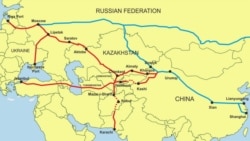“The New Silk Road initiative is a reflection of the United States’ enduring commitment to [South and Central Asia], a recognition of the vital importance of economic and energy connectivity, and a representation of our belief that shared prosperity can lead to stability and security,” said U.S. Department of State Assistant Secretary for South and Central Asian Affairs Nisha Desai Biswal.
Central Asia is one of the least integrated geographic regions in the world, with only about six percent of total trade occurring within the region.
While Central Asia is land-locked, there’s no reason for it not to be land-linked.
“The United States strongly believes that with the right investments today, Central Asian countries and Afghanistan can position themselves to share in Asia’s rise,” Assistant Secretary Biswal said.
Working with the countries in the region, donors, and international financial institutions, the United States is pursuing a four-pronged strategy to bolster regional connectivity as part of its New Silk Road initiative.
“We are focused on building a regional energy market, facilitating trade and transport, improving customs and border procedures, and linking businesses and people,” Ms. Biswal said. “The success of these efforts will be critical for securing Afghanistan’s economic ties with its neighbors and creating important ties between Central and South Asian economies.”
The region’s political and ethnic diversity may make for complicated politics, but it also underscores its untapped potential.
“What some perceive as an isolated economic zone, to others equals one of the last true frontier markets for development, investment, innovation, and growth,” Ms. Biswal said.
Expanding trade ties within the region and pointing south – through Pakistan and to India – can be a game-changer.
“By connecting to new markets, trade ties can boost political stability within the region and create additional incentives for countries to work together on shared challenges. Having a diverse set of economic connections also reinforces independence and sovereignty,” Ms. Biswal continued.
“Economic connectivity by itself is not enough to create enduring peace and prosperity,” said Ms. Biswal. “Countries in the region need to strengthen transparent and accountable governance, adopt environmentally-sustainable growth policies, and create inclusive political and economic systems that provide opportunity for all –especially for women and ethnic minority populations.”

















